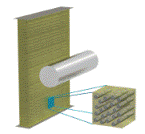Mechanical and Materials Engineering, Department of

Department of Engineering Mechanics: Dissertations, Theses, and Student Research
Date of this Version
Summer 7-31-2015
Document Type
Dissertation
Abstract
Porous materials have attracted massive scientific and technological interest because of their extremely high surface-to-volume ratio, molecular tunability in construction, and surface-based applications. Through my PhD work, porous materials were engineered to meet the design in selective binding, self-healing, and energy damping. For example, crystalline MOFs with pore size spanning from a few angstroms to a couple of nanometers were chemically engineered to show 120 times more efficiency in binding of large molecules. In addition, we found building blocks released from those crystals can be further patched back through a healing process at ambient and low temperatures down to -56 ºC. When building blocks are replaced with graphenes, ultra-flyweight aerogels with pore size larger than 100 nm were made to delay shock waves. More stable rigid porous metal with larger pores (~um) was also fabricated, and its performance and survivability are under investigation. Aside from experimental studies, we also successfully applied numerical simulations to study the mutual interaction between the nonplanar liquid-solid interface and colloidal particles during the freezing of the colloidal suspensions. Colloidal particles can be either rejected or engulfed by the evolving interface depending on the freezing speed and strength of interface-particle interaction. Our interactive simulation was achieved by programming both simulation module and visualization module on high performance GPU devices.
Advisor: Li Tan


Comments
A dissertation Presented to the Faculty of The Graduate College at University of Nebraska In Partial Fulfillment of the Requirements For the Degree of Doctor of Philosophy, Major: Engineering (Materials Engineering), Under the Supervision of Professor Li Tan. Lincoln, Nebraska: August, 2015
Copyright (c) 2015 Zhanping Xu